SHARES
| FacebookTwitter |
A little after 1:20 AM on March 28th, 1942, searchlights on both sides of the Loire Estuary flooded the waterway to reveal the convoy of 12 motor launch boats, a motor gun boat, motor torpedo boat and a destroyer which had somehow managed to slip over the sand banks flying German colors and signal lighting friendly code.
That little delay didn’t last long before the Germans guarding the Estuary and the vital Saint Nazaire harbor and Normandie dry dock opened up all their guns on the approaching British sailors and commandos. At 1:28 AM, Lieutenant Commander Stephen Halden Beattie ordered the Royal Navy’s White Ensign raised and kept his command, the destroyer HMS Campbeltown, sailing for her target: ramming the gates of the dry dock.
A few minutes of exchanged gunfire with the German shore positions later, Campbeltown drove her weight into the gates, pushing 33 feet into the dock. A commando group divided into assault, demolition, and protection teams disembarked, cleared the area, and blew up the dock’s water pump and gate machinery at great cost of life.

The naval facilities at Saint Nazaire, which included a port outside the gates to two basins, submarine pens, and the only dry dock on the Atlantic side of the British naval blockade that could hold ships like the Tirpitz, sister ship of the Bismark, that were priceless to Hitler’s war effort.

Trying to limit civilian casualties, the British ruled out an air raid to destroy the naval compound and the Royal Navy didn’t believe they could get their ships within range to bombard it without being detected. Combined Operations Headquarters took the job and with a massive joint effort between various branches of the services, managed to rig together Operation Chariot, The Greatest Raid of All Time (the name of the BBC documentary narrated by Jeremy Clarkson).
Commandos and men from the Royal Navy and Royal Engineers comprised the main force of the raid. The Naval Intelligence Division, Secrete Intelligence Service (SIS), the War Office’s Military Intelligence, Royal Navy’s Operational Intelligence, and the Air Ministry’s Air Intelligence all contributed to the operation. Technical journals from before the war detailing aspects of Saint Nazaire were studied in depth.

Northeast of the port which held the new gates, and across the basin from the submarine pens) and at the Old Mole jetty. All the groups had separate teams for assault, demolition, and protection and objectives were set to cripple the harbor and German naval operations.
Furthermore, Campbeltown’s bow was filled with 4.5 tons of high explosives hidden in concrete and timed to blow hours after the raid was over.
Continued from Page 1

The Old Mole and old gates were not secured and with most of the other boats destroyed or being destroyed, the 100 or so commandos alive on land, lead by Lieutenant Colonel Charles Newman, had to escape on foot.

Eighty-nine decorations were awarded for Operation Chariot, many posthumously, including five Victoria Crosses and four Croix de Guerre (Britain and France’s highest military honors).
From a series of interviews with people (fighters and civilians) to do with World War II gathered from the Imperial War Museum by Max Arthur and called Forgotten Voices of the Second World War. Comes the story of Beattie being interrogated by a German officer. The officer taunted Beattie, claiming the damaged inflicted by the raid would be easy to repair, implying the great loss of life to have been a waste.

“We’re not quite as foolish as you think!” .
By Colin Fraser for War History Online
All photos sourced from wikipedia.org


Δεν υπάρχουν σχόλια:
Δημοσίευση σχολίου